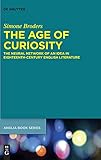The Age of Curiosity : The Neural Network of an Idea in Eighteenth-Century English Literature / Simone Broders.
Material type: TextSeries: Buchreihe der Anglia / Anglia Book Series ; 72Publisher: Berlin ; Boston : De Gruyter, [2021]Copyright date: ©2021Description: 1 online resource (X, 316 p.)Content type:
TextSeries: Buchreihe der Anglia / Anglia Book Series ; 72Publisher: Berlin ; Boston : De Gruyter, [2021]Copyright date: ©2021Description: 1 online resource (X, 316 p.)Content type: - 9783110721911
- 9783110722208
- 9783110722048
- Creation (Literary, artistic, etc.)
- Curiosities and wonders in literature
- Curiosity in literature
- Curiosity
- English literature -- 18th century -- History and criticism
- Idea (Philosophy)
- Neural networks (Neurobiology)
- Aufklärung
- Englische Literatur
- Enlightenment
- Long Eighteenth Century
- curiosity
- network theory
- 820.9/353 23
- online - DeGruyter
- Issued also in print.
| Item type | Current library | Call number | URL | Status | Notes | Barcode | |
|---|---|---|---|---|---|---|---|
 eBook
eBook
|
Biblioteca "Angelicum" Pont. Univ. S.Tommaso d'Aquino Nuvola online | online - DeGruyter (Browse shelf(Opens below)) | Online access | Not for loan (Accesso limitato) | Accesso per gli utenti autorizzati / Access for authorized users | (dgr)9783110722048 |
Browsing Biblioteca "Angelicum" Pont. Univ. S.Tommaso d'Aquino shelves, Shelving location: Nuvola online Close shelf browser (Hides shelf browser)
Frontmatter -- Contents -- Scribal Abbreviations -- Tables and Illustrations -- Acknowledgements -- Preface: Networking the Age of Curiosity: Unmasking the Myth -- 1 Original Sin or Secret of Happiness? An Introduction to Curiosity -- 2 “The Thinking Animal”: Lovejoy’s History of Ideas -- 3 Methodology of the Study -- 4 Curiosity: Origins of the Debate -- 5 Curiosity Across Different Media -- 6 Agents of Curiosity and the ‘New Science’ -- 7 Secret Chambers, Hidden Chests, and the Mysterious Self: Objects of Curiosity in Romanticism -- 8 Conclusion: Legitimacy of Curiosity in the Eighteenth Century and Beyond -- Works Cited -- Dictionaries, Thesauri -- Index
restricted access online access with authorization star
http://purl.org/coar/access_right/c_16ec
Challenging the ‘success story’ of curiosity from original sin to intellectual virtue, this study uses an innovative methodological approach to the history of ideas as a non-teleological neural network based on current research in information technology and neurophysiology. The network offers a dynamic alternative to the ‘development’ of curiosity within the progress-oriented mythology of the Enlightenment, emphasizing the oscillation and interaction of ideas within the processes of their construction, as well as exposing the power relations behind them. The text corpus focuses on enactments of curiosity in English literature of the 'Long' Eighteenth Century (c. 1680-1818), such as transgression of boundaries, breach of taboo, gendered curiosity, sensationalism, or academic endeavour, bringing together a variety of examples from all major genres. The Age of Curiosity contributes to current debates on a post-Foucauldian renewal of Lovejoy’s history of ideas in Enlightenment studies, exploring both curiosity as an indispensable trait for the search of answers to the fundamental yet unresolved questions of ‘identity’ or ‘truth’, and its potential as cura, the care for others and the world.
Issued also in print.
Mode of access: Internet via World Wide Web.
In English.
Description based on online resource; title from PDF title page (publisher's Web site, viewed 25. Jun 2024)









